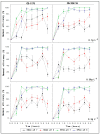Effectiveness of Kaolinite with and Without Polyaluminum Chloride (PAC) in Removing Toxic Alexandrium minutum
- PMID: 40864071
- PMCID: PMC12390390
- DOI: 10.3390/toxins17080395
Effectiveness of Kaolinite with and Without Polyaluminum Chloride (PAC) in Removing Toxic Alexandrium minutum
Abstract
Alexandrium spp. blooms and paralytic shellfish poisoning pose serious economic threats to coastal communities and aquaculture. This study evaluated the removal efficiency of two Alexandrium minutum strains using natural kaolinite clay (KNAC) and kaolinite with polyaluminum chloride (KPAC) at three concentrations (0.1, 0.25, and 0.3 g L-1), two pH levels (7 and 8), and two cell densities (1.0 and 2.0 × 107 cells L-1) in seawater. PAC significantly enhanced removal, achieving up to 100% efficiency within two hours. Zeta potential analysis showed that PAC imparted positive surface charges to the clay, promoting electrostatic interactions with negatively charged algal cells and enhancing flocculation through Van der Waals attractions. In addition, the study conducted a cost estimate analysis and found that treating one hectare at 0.1 g L-1 would cost approximately USD 31.75. The low KPAC application rate also suggests minimal environmental impact on benthic habitats.
Keywords: Alexandrium spp.; cost estimate; harmful algal blooms; kaolinite; modified clays; removal rates; seawater; zeta potential.
Conflict of interest statement
The authors declare no conflicts of interest.
Figures




Similar articles
-
A synthetic and transparent clay removes Microcystis aeruginosa efficiently.Harmful Algae. 2024 Aug;137:102667. doi: 10.1016/j.hal.2024.102667. Epub 2024 Jun 12. Harmful Algae. 2024. PMID: 39003027
-
Controlling harmful algal blooms through clay flocculation.J Eukaryot Microbiol. 2004 Mar-Apr;51(2):169-72. doi: 10.1111/j.1550-7408.2004.tb00541.x. J Eukaryot Microbiol. 2004. PMID: 15134251 Review.
-
Sustainable high-flux ceramic membrane operations for seawater pretreatment under diverse algal bloom intensities.Water Res. 2025 Sep 1;283:123879. doi: 10.1016/j.watres.2025.123879. Epub 2025 May 21. Water Res. 2025. PMID: 40446404
-
Temperature-Driven Intraspecific Diversity in Paralytic Shellfish Toxin Profiles of the Dinoflagellate Alexandrium pacificum and Intragenic Variation in the Saxitoxin Biosynthetic Gene, sxtA4.Microb Ecol. 2025 Aug 8;88(1):87. doi: 10.1007/s00248-025-02586-1. Microb Ecol. 2025. PMID: 40779244 Free PMC article.
-
Macroalgal blooms alter community structure and primary productivity in marine ecosystems.Glob Chang Biol. 2014 Sep;20(9):2712-24. doi: 10.1111/gcb.12644. Epub 2014 Jul 4. Glob Chang Biol. 2014. PMID: 24890042
References
-
- Lewis A.M., Coates L.N., Turner A.D., Percy L., Lewis J., Mock T. A review of the global distribution of Alexandrium minutum (Dinophyceae) and comments on ecology and associated paralytic shellfish toxin profiles, with a focus on Northern Europe. J. Phycol. 2018;54:581–598. doi: 10.1111/jpy.12768. - DOI - PubMed
-
- Hallegraeff G.M., Schweibold L., Jaffrezic E., Rhodes L., MacKenzie L., Hay B., Farrell H. Overview of Australian and New Zealand harmful algal species occurrences and their societal impacts in the period 1985 to 2018, including a compilation of historic records. Harmful Algae. 2021;102:101848. doi: 10.1016/j.hal.2020.101848. - DOI - PubMed
-
- Anderson D.M., Fensin E., Gobler C.J., Hoeglund A.E., Hubbard K.A., Kulis D.M., Landsberg J.H., Lefebvre K.A., Provoost P., Richlen M.L. Marine harmful algal blooms (HABs) in the United States: History, current status and future trends. Harmful Algae. 2021;102:101975. doi: 10.1016/j.hal.2021.101975. - DOI - PMC - PubMed
-
- Manfrin C., De Moro G., Torboli V., Venier P., Pallavicini A., Gerdol M. Physiological and molecular responses of bivalves to toxic dinoflagellates. Invertebr. Surviv. J. 2012;9:184–199.
MeSH terms
Substances
LinkOut - more resources
Full Text Sources
Miscellaneous

